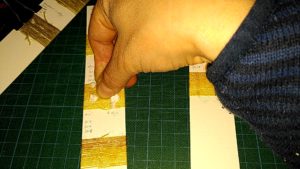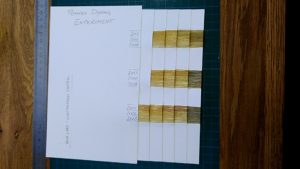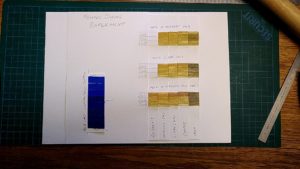Search the Blog
Latest Comments
The Dye Experiment Card.
It took me a while of thinking on how to best present the results. I wanted them to be comparable across both the different metals and the different runs of the experiment. Because of the lack of a reference in the add-on 2013, there were exactly three different samples for each data point, which made things nicely line up in the end.

The cardboard strips were labelled on the back, I wound the threads on and fixed them temporarily with sticky tape, then glued them into place with PVA wood glue. I tried to line them up as perfectly as possible, and in the end, there were only very slight variations from the perfect line.

Another thing I pondered for a while: whether I would write the info necessary by hand, or print it on. I decided, in the end, to do it by hand - there were bits that I would need to do by hand anyways, as I had not printed the metal name on the strips before winding the threads on, and now it was too late. Because I thought it would be weirder to mix than to do it all by hand... well, there you go.
I chose pencil for the writing - because that is very lightfast, and I didn't have a pen that I was sure would be appropriately lightfast. (Yes, I could have used iron gall ink - in theory, but I am not practised at handlettering with that, and, well... perfectionism, anyone?).

As the final thing, I added a blue card - because I could. Because the exhibition and the light exposure of the samples might just as well serve as a fade test; for that, the strips with yarn are layered so they are half exposed and half protected. The blue card is also half exposed and half protected.
I already did a lightfastness test with samples from the last experiment run, in that case fabric samples, but there was none yet with the yarns from that or the previous runs. This will be remedied now! It is, obviously, not a really perfect and proper test as the yarns have seen a few hours (unknown amounts...) of indoor light before in their existence, but it's better than not doing the test at all, or than not adding the bluecard for the reference... so. There you go.
The whole assembly was then glued to another carrier layer of cardboard, and then everything went into a parcel and on its merry way to the exhibition. I hope it will be interesting for the visitors!
Comments 2
I'm not sure that the iron gall ink would have been very lightfast either: last spring I did an informal¹ light resistance test on a number of fountain pen and calligraphy inks and all of the iron gall ones paled significantly into a light brown; they are still somewhat readable, but not necessarily easily.
None of them were pure iron gall inks, they all had blue or in one case purple dye added, and two out of three were even fountain pen safe, but it would be enough for me to want to test it before committing to its use in a place where light fastness is required.
¹ I had no blue wool for comparison, I just left the partially covered samples on a south-east facing window for 3 months to get a yes-no answer
I've used iron gall ink for our doorbell label a few years ago, and yes, it did fade quite a bit over time. It was pretty lightfast, though - although I am not sure how it would compare to a modern ink. Mine was pure iron gall, no extra colour added.
Your informal test is more or less the rule, by the way - most lightfastness tests, unless there's a real need for calibration or a reference, are done without a blue card. (One of the reasons for this is that you have to get a blue card first, and they cost a bit more than a few cents.) I remember a colleague of mine doing a similar test like you did for inks used in archaeological drawings - he wanted to make sure that there would be no untoward fading.
From my doorbell label experiences, I would assume the iron gall ink to hold out until the exhibition is over without fading too badly. The pencil, however, that I was really sure about!



